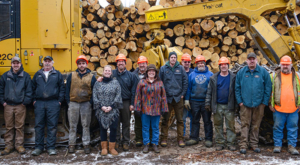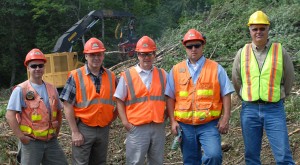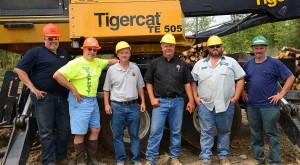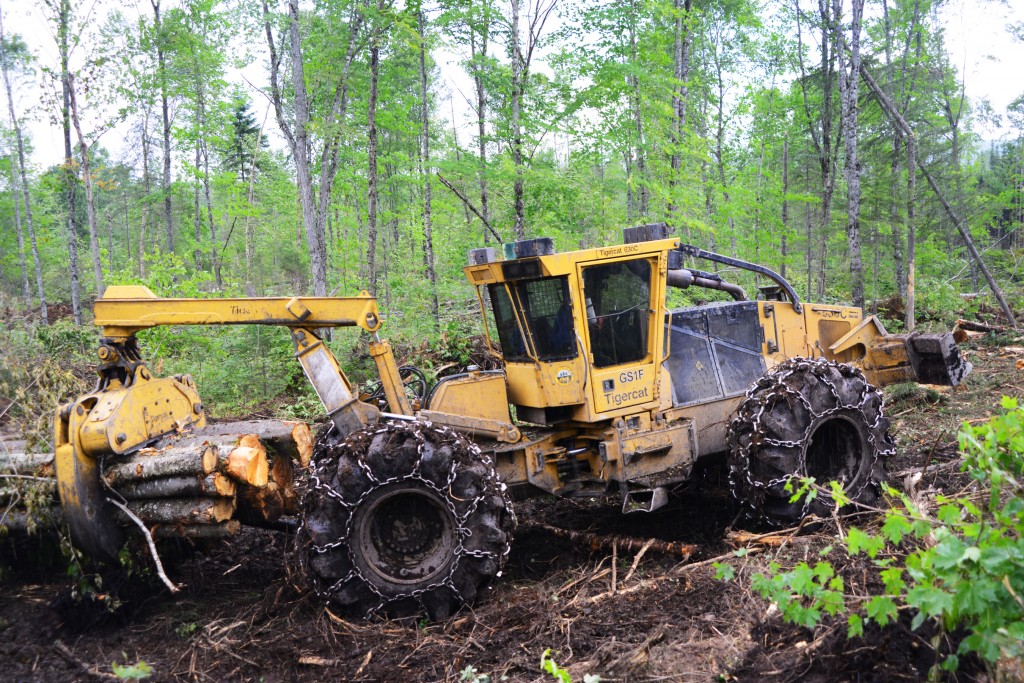
Mike is working to optimize the duty cycle in tough conditions and more closely match component lifespan with structural life.
— Paul Iarocci
Mike Nadeau, who co-owns White Oak Inc. with his father, asks a lot of questions. A progressive thinker, he sometimes receives ideas and answers from unlikely places. When he presents to me a recently discovered article profiling his grandfather’s logging operation in the April 1959 edition of The Northeastern Logger, it is obvious he has already scoured the short piece for practical information, drawing interesting parallels between past and present.
Titled, “The Patrick Nadeau Logging Operations”, the article reads, “As Mr. Nadeau recalls, the illness of men was one of his most serious problems. They had to be conveyed to the nearest hospital, which was about one hundred miles away, by teams in sleds.” Mike emphasizes that it was not just the sick men that were lost but also the healthy ones that had to guide them out of the bush.
The article goes on to describe the changes that Patrick saw over his lifetime: improved camps with electricity, hot running water, refrigerators and “good sleeping quarters” replaced log cabins insulated with moss, stuffed straw mattresses and barrels of water sourced from the nearest stream.
Fast forward to the 21st century. While the technological aspects of the business have changed drastically, from horse teams to rudimentary tractors and dozers to the complex fly-by-wire marvels of today, some challenges remain nearly the same and they are invariably tied to the human factor. Let’s face it, people haven’t changed nearly so much as logging machines in the last 70 years. “It takes one year for an operator just to learn the basics,” says Mike. “When you create a good operator you need to keep him.”
Although Mike is a third generation logger, he does not own a third generation business. When his grandfather retired, the business retired with him and his three sons went their separate ways. That is when Mike’s father, Vernal, went into trucking.
Mike describes how Vernal expanded from one to three trucks in 1982, with Mike driving one for many years. In 1988, Mike and Vernal expanded into loading with a new venture, White Oak Inc. By 1990, White Oak was harvesting wood for J.D. Irving. As Mike puts it, “We were good at trucking and loading but not so good at logging.”
Irving expanded its land ownership in Maine, and by 2000, had 27 contractors. Mike felt that White Oak needed to become more efficient, noting that with one exception, all the contractors at the time were doing 200–400 cords per week. The exceptional contractor produced about 700 cords while achieving the same quality as everyone else. What was this contractor doing differently?
Mike questioned the man at length and could only discover two differences. “When I asked what time he ate his lunch, he chuckled and said there was no set time. And many times he forgot to eat. The second thing, he burned twice as much fuel as us.”
Adjusting attitudes
After much thought, Mike decided the reason the man forgot to eat lunch was because he was so extremely focused. It was his attention on the task at hand that was important and consequently he worked the machine harder. “It is like driving a car, when half the time you don’t remember the last town you drove through,” explains Mike. “Who is doing the driving, you or the car? We needed to be the driver because at the time we were going pay check to pay check and everything we tried was not working.”
After countless hours of research, Mike learned some valuable information. The Dream Manager, by Matthew Kelly, described a janitorial company with 250 employees and a 75% employee turnover ratio. Three years later, the company employed 750 and went three months with no turnover. “First thing, you must have a plan,” says Mike. “Then you get the employees to believe in your company and the direction you are going.” After reading Good to Great by Jim Collins, Mike realized that he must implement a structure for the men to follow, no matter how small the detail. “We also learned that we must take what we are good at, simplify, and become better at it.”
Mike recalls that getting started was an enormous challenge. “First we met with the twelve men we had working at the time and told them about our plan. We were going to shorten the hours from fourteen to eleven with the same or more pay. We put bigger fuel tanks on the skidders, so the operators didn’t have to refuel as often and we installed better entry steps, better lights and better windows on all the equipment.” Mike also supplied transportation from home to jobsite, started an employee health insurance program and increased the number of holidays. “All this would improve the working conditions for the men, which in turn would improve their quality of life. When they went home, they were less fatigued, which would create a better family atmosphere and on Monday morning they were happy to come to work, more times than not.” The idea was that improved quality of life would reduce turnover.
“The cost of this structure—and there is always a cost—was that I needed them to do the driving and stay focused 100% of the time. There was initially some pushback from the crew; two men quit the first Monday morning that we implemented the structure. But by the third week most everyone had calmed down and adjusted to the new norm.” White Oak’s production tripled not because of the introduction of some new technology or technical process, just the implementation of a structure that, in turn, adjusted the mindset of the crew.
Beating inflation
White Oak’s next challenge came in the form of a squeeze with lower rates on one side and ever escalating costs on the other. Everything from fuel to insurance to wear items became more expensive and Mike became determined to beat the inflation.
White Oak traditionally ran full-tree thinning systems with a track buncher, skidder and stroke delimber at roadside. Smarter planning was a big step toward improved efficiency and reduced fuel consumption. Today, it is an established best practice for the foreman to study the topography of the site, planning the main skidder road so that it flows downhill to the corner of the yard with no 90 degree turns. Secondary buncher trails are also planned according to topography to make the wood flow as smooth as possible.
Armed with GPS, the feller buncher operator follows the map, making practical adjustments where required and then submits the revised map to the skidder and limber operators. The skidder operators use the maps to mark off trails that have been skidded so everyone on the crew knows where the wood is, eliminating unnecessary travel. In addition, the operators record all fuel consumption to be later input into Mike’s extensive set of software models that track all aspects of the business. “Before these best practices were instituted, fuel consumption averaged 1.4 gallons for every ton [5,8 L/t] that was put to roadside. Now we are around one gallon per ton [4,2 L/t] on average. Fuel consumption is the key to everything.”
Mike has put similar structures in place, governing every aspect of the business. “Everything in my shop is automatically reordered. Every wear item, paper towels, everything. This saves me a lot of time. I am never on the phone ordering anything, unless there is a breakdown.” Each crew has an on-site service trailer set up and stocked identically with a system in place for the employees to quickly find, track and replenish inventory. We always try to make the job easier and safer. If there is a problem, we always ask, ‘How did it happen? How do we prevent it?’ Then and only then do we fix it.”
The future: machine lifespan
According to Mike, employing highly trained operators with the right attitude improves production and extends machine lifespan. When Mike showed me the spreadsheet for his ten-year debt/equity projections, he did some quick math. Assuming a 20,000 hour machine life and 3% annual inflation rate for the price of new machinery, “My payments would increase from $50,000 to $89,000 per month ten years from now. We are not talking about anything else, just equipment. With that in mind, can the land companies increase rates enough to keep up with inflation?” Performing some sensitivity analysis, Mike bumps the skidder and buncher lifespan up to 25,000 hours. The result? His payments stay the same and he doesn’t lose any equity in the projection. “So the question arises, how do we get to where we want to be?
Today, White Oak’s Tigercat equipment fleet consists of six 822 series feller bunchers (including the pink one, reported in BTB, July 2013), four 822 series harvesters, five 630C skidders, two excavator-based stroke delimbers and one 1055B forwarder. Two other forwarders round out the CTL crews. So far, the oldest Tigercat buncher has clocked over 17,000 hours and the two oldest harvesters (converted from feller bunchers) have 27,000 hours. In trying to wrap his mind around the inflation problem at the time, Mike first asked himself, “Do we have the right machines? And can we get to where we want to be with them?”
“We determined that with Tigercat equipment, we can get to where we want to be. For we feel they are the best machines on the market with the longest potential structural life,” Mike asserts. He also hit on an idea to further extend lifespan by modifying his harvesting system and machine mix. In 2012, Mike began the transition from delimbers to processors. He is projecting a processor lifespan of 35,000 hours and plans to repurpose 20,000 hour feller bunchers into processors. This new tactic has already resulted in reduced monthly payments and enhanced the debt-to-equity ratio.
Mike has also introduced best practices to extend useful life. When it was observed that skidder drive systems were not lasting long enough compared to machine structure, he analyzed the duty cycle and fuel consumption. Mike determined that in tough terrain, the operators were putting too much demand on the driveline components. To remedy, he added a second skidder to the crews and cut down the grapple tongs to decrease the size of the loads. “Now we are seeing much longer tire life and no more chunks of rubber gone and I can extend my skidder lifespan to 25,000 hours, with two sets of drive systems.”
White Oak introduced similar best practices for feller buncher operation with focus on shortening the boom envelope. “Even though the machines can lift the trees at full reach, it doesn’t mean you have to every time,” says Mike. Feller buncher trail spacing was reduced from 100 ft (30 m) between trails to 75 ft (22 m), effectively decreasing feller buncher travel. “Now we get the skidder to double up the bunches instead. Just the trail spacing we implemented saves approximately 2,275 feet [690 m] of tracking between trails on every acre that we harvest.” On average, the bunchers harvest about ten acres (4 ha) per day over a 42 week year. “We are looking at a savings of 800 miles [1 300 km] a year of tracking. Hopefully with these changes and many others, we will survive.”
Another area of concern was an imbalance between White Oak’s winter and summer volumes. “As a consequence, we would have to hire additional operators in winter that were not as well trained or did not believe in the structure,” Mike explains. “This extra volume came at much higher cost per ton.”
For example in summer 2011, White Oak put 12,100 hours on the two full-tree systems, which in turn produced 118,000 tons, averaging 0.98 gal/ton. The following winter, with six additional men and a shorter timeframe, the two crews did 12,200 hours but only produced 90,000 tons at a cost of 1.42 gal/ton. “We lost approximately $400,000. So the question arose again, how do we get to where we want to be?”
In the spring of 2012, Mike met with Seven Islands Land Company, asking if it was possible to switch some of the winter harvest volume to summer. “They were interested only if we would convert two of our full tree systems over to cut-to-length systems.” Mike switched two systems that spring and converted a third in 2013. “This eliminates hiring additional untrained workers for just three months per year. Hopefully with steadier employment we will establish a core group of employees on the cut-to-length system and this will be the answer to our cash flow shortfall in the winter months.”
The CTL systems are double shifted. Two single shift full tree crews work for Orion. Total annual production is about 300,000 tons, almost entirely selective felling. White Oak has 36 employees including Mike’s wife, Leisa, who is the office manager and oldest son Charlie, an operator training to be a foreman. Vernal owns 50% of the business and looks after timber transport with a fleet of six trucks.
Aside from the structural integrity of the Tigercat machines, a big factor in the purchase decision for Mike is the well managed service department, strong technicians and excellent parts availability at Frank Martin Sons. “They want to keep me in business,” he says, adding that FMS always gives the customer options, for example, offering new or reconditioned parts and working to improve or repair the machine faster to reduce downtime.”
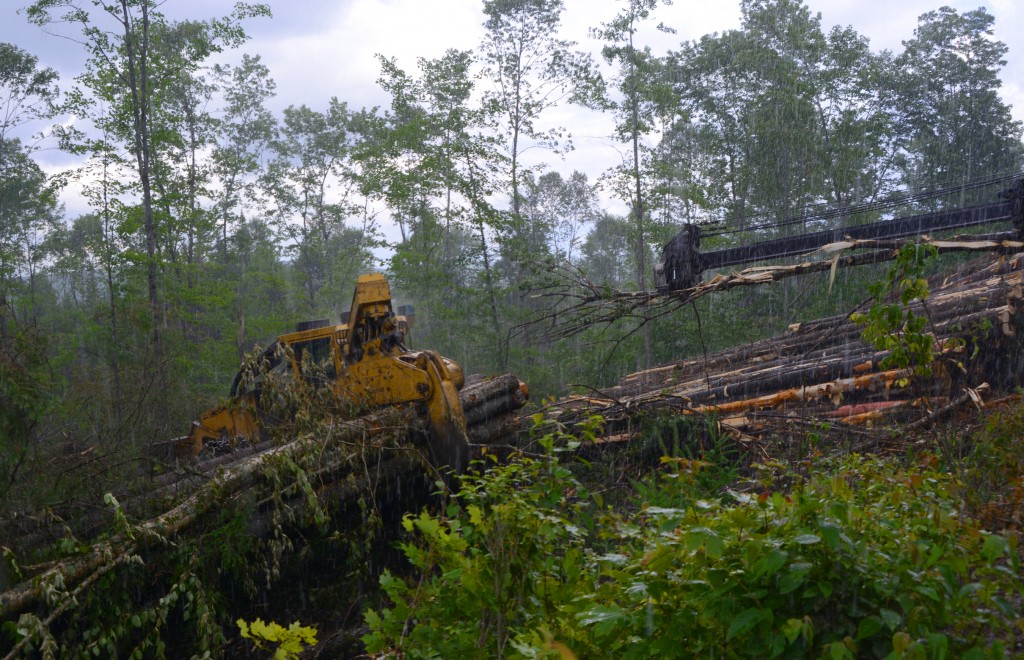
The 630C delivers a load to the yard.
“I can also talk directly to the Tigercat engineers and owner about future plans,” says Mike. “When I spoke to the owner [Ken MacDonald] about the plan to extend the life of our machines, he said he gets upset when he hears that someone traded their machine at 10,000 hours. He told me that besides the major components, the machines should get between 25,000 and 40,000 hours. He said a customer just upgraded a processor that had 48,000 hours on it. The glow he had when he told me this story demonstrated how proud he was.”
For Mike, this is one of many reasons he chose Tigercat as White Oak’s primary manufacturer and Frank Martin to sell and service the machines. “We can no longer take the bad with the good and hope for the best. We must explore every opportunity, turn over every rock and question everything. Unless we all work together as partners—the equipment manufacturers, the landowners, the dealers and most of all, the employees—we will never be able to overcome inflation.”




